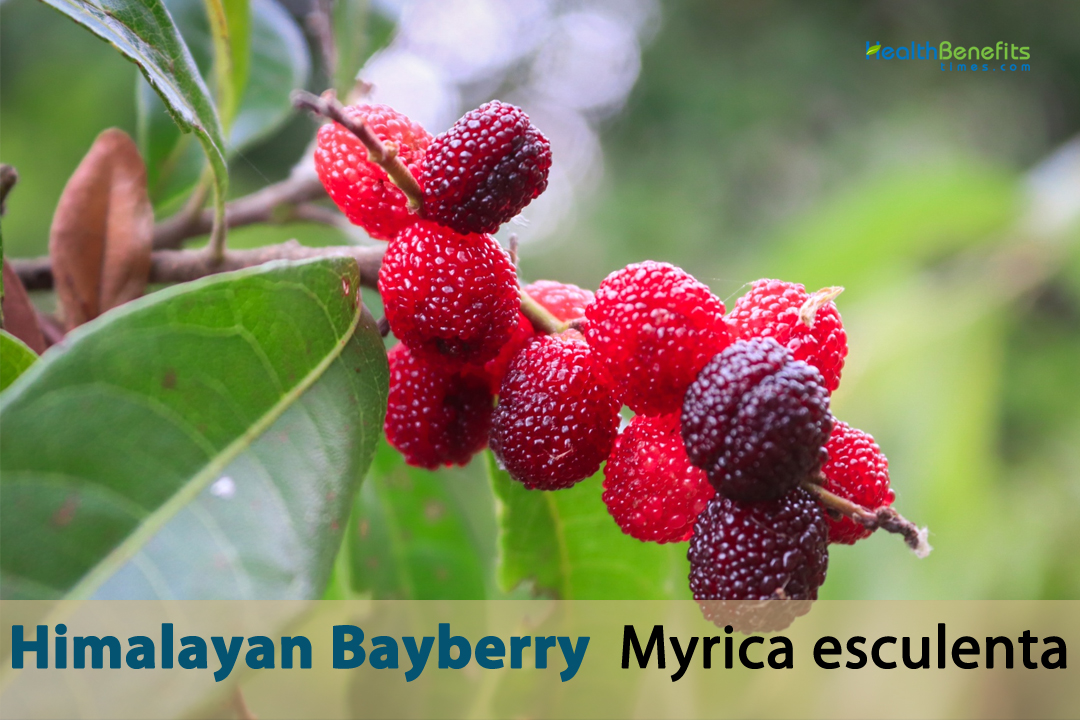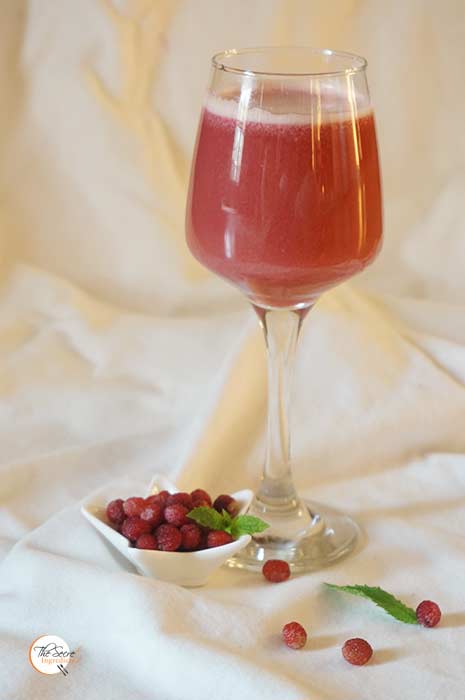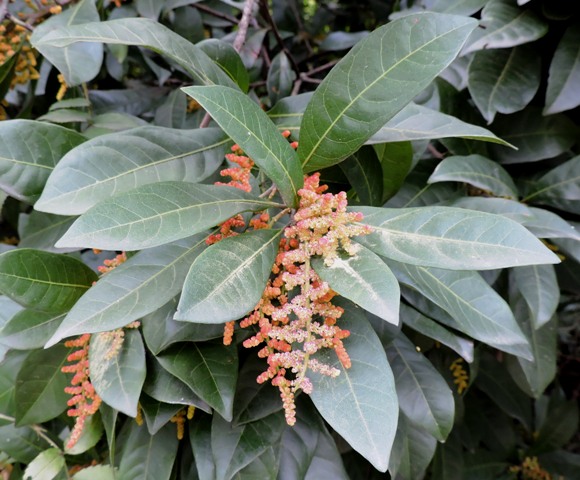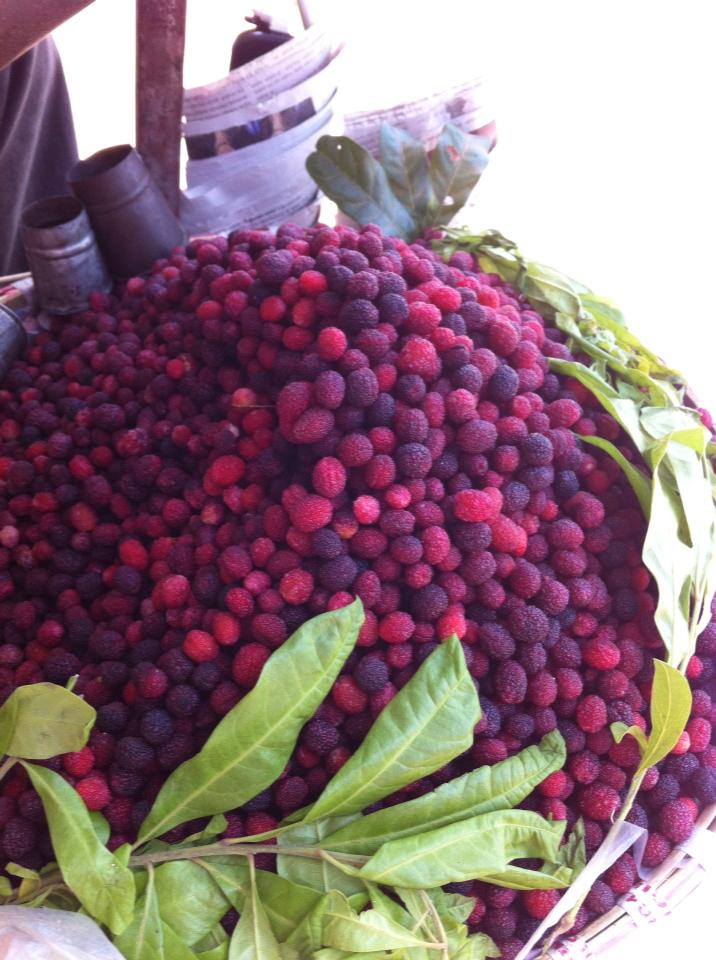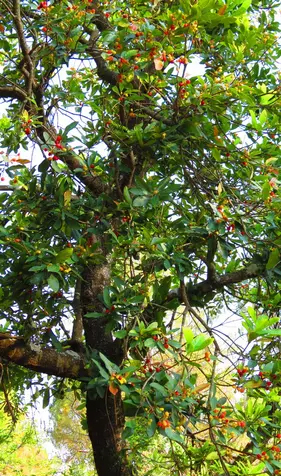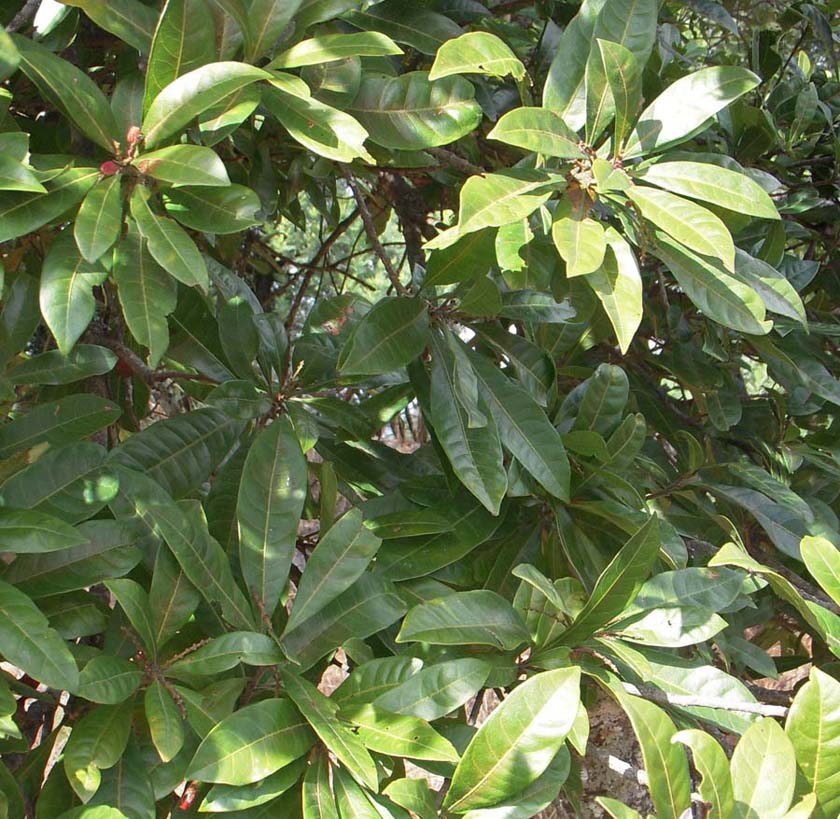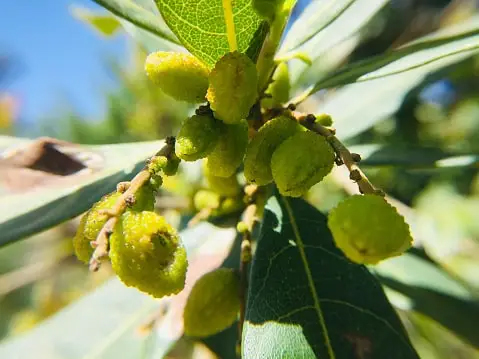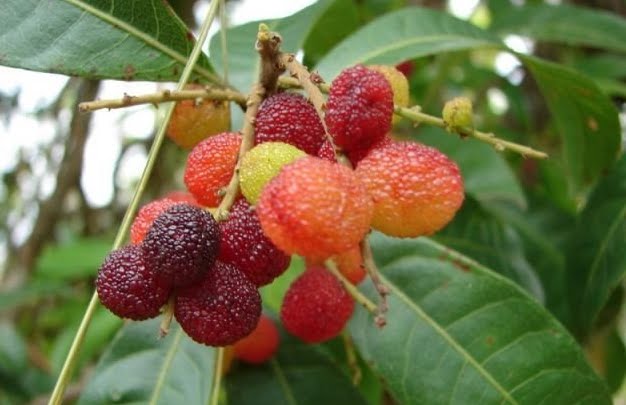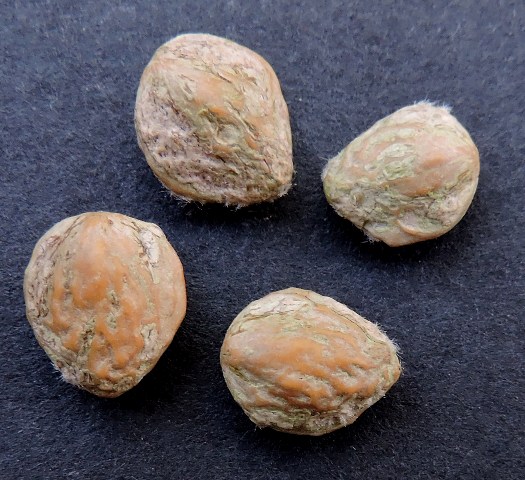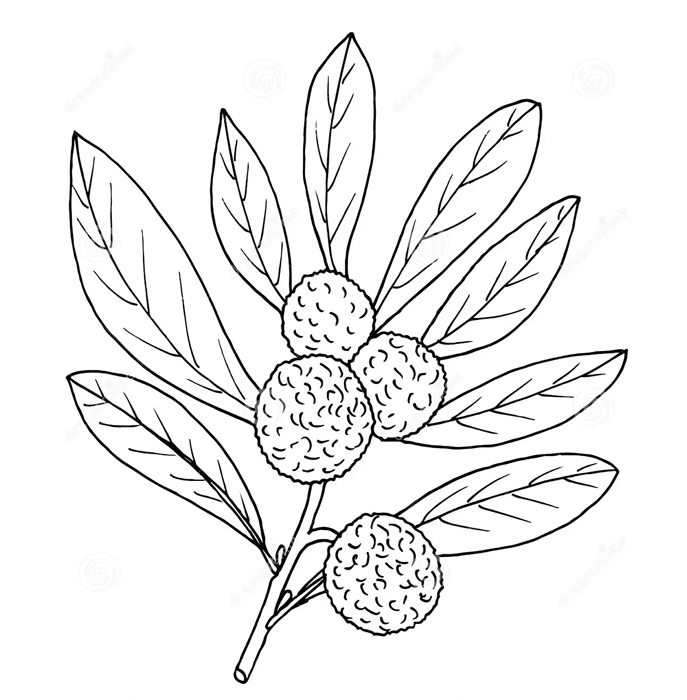| Himalayan Bayberry (Kaphal) Quick Facts | ||
|---|---|---|
| Name: | Himalayan Bayberry (Kaphal) | |
| Scientific Name: | Myrica esculenta | |
| Origin | Himalayas of Nepal, in southern China east to Guangdong province, in Burma, Indo-China, Thailand and hilly regions of northern India | |
| Colors | Initially green and turn reddish-purple or black when ripe | |
| Shapes | Small, round to ovoid succulent berry, usually around 1-1.5 cm in diameter | |
| Taste | Blend of tart, slightly tangy, sweet, and earthy | |
| Major nutrients | • Vitamins • Minerals • Dietary Fibers • Antioxidants • Natural Acids • Phytonutrients • Carbohydrates • Calories |
|
| Health benefits | Digestive Health, Blood Sugar, Cholesterol Management, Immune System, Skin Health, Liver Health, Heart Health, Gastrointestinal Health, Weight Management, Respiratory Health, Dental Health, Wound Healing, Eye Health | |
| Name | Himalayan Bayberry (Kaphal) |
|---|---|
| Scientific Name | Myrica esculenta |
| Native | Himalayas of Nepal, in southern China east to Guangdong province, in Burma, Indo-China, Thailand and hilly regions of northern India especially in the regions of Garhwal , Kumaon and Eastern Part of Himayala of Uttarakhand |
| Common Names | Himalayan Bayberry, Kaphal, Katphala, Box Myrtle, Nepalese Bayberry, Kafal, Chinese Boxthorn, Kafala, Kaphala, Kafala Bayberry, Kafal Berry, Box Myrtle Berry, Nepalese Boxthorn, Himalayan Waxberry, Nepalese Waxberry, Katphala Fruit, Kafal Fruit, Himalayan Boxthorn, Himalayan Wax Myrtle, Nepal Box Myrtle |
| Name in Other Languages | Albanian: Himalayan Boronicë Armenian: Himalayan Bur (Հիմալայան Բուր) Arabic: Tut Himalaya (توت هيمالايا), Al-Tut Al-Himalaya (التوت الهيمالاي) Assamese: Buranj (বুৰঞ্জ), Kafal (কাফল), Barberry (বাৰবেৰি) Azerbaijani: Himalaya Yemiş Belarusian: Himalayskaya Barvіnaka (Гімалайская Барвінака) Bengali: Kafal (কাফল), Buransh (বুরাঁশ), Himalay Bebri (হিমালয় বেবরি) Bhutanese: Kyag Pha La (སྐྱག་ཕ་ལ), Druk Thro (དབུ་རང་ཁྲོ་) Bodo: Barberry (बरबेरी) Bulgarian: Himalayska Borovinka (Хималайска Боровинка) Chinese: Xǐmǎlāyǎ Méi (喜马拉雅莓), Xi Mǎ Lā Yǎ Là Guǒ (喜马拉雅蜡果), yáng méi (杨梅), Máo yángméi (毛杨梅), Máo yángméi gēn pí (毛杨梅根皮), Máo yángméi pí (毛杨梅皮) Croatian: Himalajska Borovnica Czech: Himalájská voskovka, Himalájský Borůvka Danish: Himalaya Voksmyrte, Himalayan Bær Dogri: Barberry (बरबेरी) Dotyali: Kaaphal (काफल) Dutch: Himalaya Wasbes, Himalayaanse Bes English: Himalayan Bayberry Filipino: Himalayan Berry Finnish: Himalajanvahaomena, Himalajan Marja French: Baies de l’Himalaya, Georgian: Himalaisuri qota (ჰიმალაისური ყოთა) German: Himalaya-Wachsbeere Greek: Valsamikó Vatómouro tou Imaaláia (Βαλσαμικό Βατόμουρο του Ιμαλάια), Valsamoveríkoko ton Himalaíon (Βαλσαμοβερίκοκο των Ιμαλαΐων) Gujarati: Kafal (કાફલ), Burans (બુરાંસ), Himalayan Bebri (હિમાલયન બેબરી) Hindi: Burans (बुराँस), Kafal (काफल), Himalayi Bebri (हिमालयी बेबरी) Hungarian: Himalája Bogyó Icelandic: Himalayan Ber Indonesian: Himalaya Berry (Himalaya Beri) Italian: Bacca dell’Himalaya Japanese: Himaraia Wakkusu Berī (ヒマラヤワックスベリー), Himayarayan Berī (ヒマラヤンベリー) Kannada: Kafalu (ಕಾಫಲು), Himalayada Bēbari (ಹಿಮಾಲಯದ ಬೇಬರಿ), Himalayada Bebari (ಹಿಮಾಲಯದ ಬೇಬರಿ) Kashmiri: Barberry (بربری) Kazakh: Himalai Shym (Гималаи Шым) Khasi: Soh-phi Konkani: Barberry (बारबेरी) Korean: Himalaya Wakseuberi (히말라야 왁스베리), Himalaya Beli (히말라야 베리) Kyrgyz: Himalay bal (Гималай бал) Limbu: Yagpati (यगपति) Macedonian: Himalajska Borovnica (Хималаска Боровница) Malay: Beri Himalaya (Beri Hima-laya) Malayalam: Kafal (കാഫൽ), Himalayan Beberi (ഹിമാലയൻ ബെബെറി), Himalaya Bebri (ഹിമാലയ ബേബരി), maruta, katfalam (കട്ഫലം) Manipuri: Himalay Beberi (হিমালয় বেবেরি), Barberry (বাৰবেৰি) Marathi: Kafal (काफळ), Burans (बुरांस), Himalayi Bebari (हिमालयी बेबरी) Maring: Kuihei Mizo: Keifang Mongolian: Himalain Takhiya (Хималайн Тахиа) Nepali: Kafal (काफल), Burans (बुराँस), Himalayan Bebri (हिमालयन बेबरी) Norwegian: Himalaya Voksmyrt, Himalayan Bær Odia: Kafal (କାଫଲ), Barberry (ବାରବେରୀ) Oriya: Himalaya Bēberi (ହିମାଲୟ ବେବେରି) Polish: Jagoda himalajska, Himalajska Jagoda Portuguese: Bagas do Himalaia Punjabi: Burans (ਬੁਰਾਂਸ), Kafal (ਕਾਫਲ), Himalayi Bebri (ਹਿਮਾਲਿਆਈ ਬੇਬਰੀ), Kā’ē phala (ਕਾਏ ਫਲ) Romanian: Himalayan Bob Russian: Gimalayskaya mirtsiya (Гималайская мирцика), Gimalayskaya buzina (Гималайская бузина), Gimalayskaya Malina (Гималайская Малина) Sanskrit: Kaphala (काफल), Madhuka (माधूक), Dvijapita (द्विजपिता), katphala, mahavalkala Serbian: Himalajska Borovnica (Хималајска Боровница) Sikkimese: Lu Drung (ཀླུ་དྲུང) Sinhala: Himalayān Beberi (හිමාලයාන් බේබරි) Slovak: Himalájska Borůvka Slovenian: Himalajska Borovnica Spanish: Baya del Himalaya Swedish: Himalaya Vaxtörne, Himalayan Bär Tajik: Himalayi Qattiqi (Гималайи Қаттиқи) Tamil: Himalaya Pēperi (ஹிமாலய பேபெரி), Kaappal (காப்பால்), Himalaya Pēpari (ஹிமாலய பேபரி) Telugu: Himalayan Bēbarr̥I (హిమాలయన్ బేబర్రి), Kafalu (కాఫలు), Himalaya Bēbarri (హిమాలయ బేబర్రీ) Thai: Madan Himalai (มะดันหิมาลัย), H̄m̀xn x̀xn (หม่อนอ่อน) Tibetan: Kya-yi Thro-gya (སྐྱ་ཡི་ཁྲོ་རྒྱ), Ka Phal (ཀ་ཕལ), Hi-ma-lo Batshe Ba (ཧི་མ་ལོ་བརྩེ་བ།) Turkish: Himalaya Dutu (Himalaya Dutu), Himalaya Balmumu Üzümü, Himalaya Düğün Çalısı Turkmen: Gimalay Goşun Ukrainian: Himalayska Zhymolost (Гімалайська Жимолость) Urdu: Bargat Berry (برگت بیری), Kafal (کافل), Himalayai Berry (ہمالیائی بیری) Uzbek: Gimalay Yemi Vietnamese: Dâu Himalaya, Thanh mai |
| Plant Growth Habit | Small or moderate sized, woody, deciduous shrub or small evergreen tree |
| Growing Climates | Open savannas, evergreen forests and sand dunes |
| Soil | Mix of loamy soil with good organic content is ideal |
| Plant Size | Around 10 to 30 feet (3 to 9 meters) tall and 8 to 20 feet (2.5 to 6 meters) wide |
| Root | Taproot gives the plant stability and lets it reach deeper into the dirt to find water and food. As the plant gets bigger, the taproot might become less important as more branching roots grow |
| Stem | Stems lignify and get stronger and stiffer. The stems can grow both up and down, which affects the shape and size of the bush as a whole. |
| Bark | Bark is soft and brittle |
| Leaf | Leaves are simple, alternate, and aromatic when crushed. They are dark green in color, elliptical in shape, and have serrated edges. |
| Flowering season | Around March to May |
| Flower | Each flower is either male or female, but not both. This plant doesn’t have any flowers that are both male and female. |
| Fruit Shape & Size | Small, round to ovoid succulent berry, usually around 1-1.5 cm in diameter |
| Fruit Color | Initially green and turn reddish-purple or black when ripe |
| Fruit Weight | About 670 mg (10.3 gr) |
| Seed | Seeds are triangular in shape and are astringent in taste |
| Flavor/Aroma | Blend of fruity, tangy, and slightly sweet scents |
| Taste | Blend of tart, slightly tangy, sweet, and earthy |
| Plant Parts Used | Leaves, berries, bark, roots, stems |
| Propagation | By seeds, Stem cuttings, Layering, Grafting |
| Lifespan | Around 30 to 50 years in their natural habitat |
| Season | Around August to October |
| Major Nutrition |
|
| Varieties |
|
| Available Forms |
|
| Health benefits |
|
Plant Description
Himalayan Bayberry (Kaphal) is a small to medium-sized, woody, deciduous bush or small evergreen tree that usually grows between 10 and 30 feet (3 to 9 meters) tall and 8 to 20 feet (2.5 to 6 meters) wide. The plant grows in savannas, woods with evergreen trees, and sand dunes. Soil that drains well is important to keep the plant from getting too wet, which it doesn’t do well with. Ideal is a mix of sandy and loamy soil with a lot of organic matter.
Different parts of the plant, like the bark and leaves, are sometimes used in traditional medicine because they might be good for you. Some of these are addressing stomach problems, fever, and other illnesses. Berries have been eaten by people in the Himalayan area for a long time and are an important part of their culture. People eat them both as fresh fruit and in different ways that change their taste. The fruit is full of healthy things like vitamins, minerals, antioxidants, and fiber. It is thought to be a healthy food and is known to have health benefits. You can make jams, jellies, syrups, juices, and even liquor drinks with the berries. You can also dry them and add them to trail mix or baked goods.
Appropriate growing environment of Himalayan Bayberry
The Himalayan Bayberry, also known as Kaphal or Katphala, is a shrub native to the Himalayan region. It is valued for its edible berries and has cultural significance in the local communities. To create an appropriate growing environment for Himalayan Bayberry, consider the following factors:
- Climate: Himalayan Bayberry does best in an environment with four clear seasons. It can handle cold weather, but it might not do well in circumstances that are very hot or dry. The best temperatures are between 10 and 25°C (50 and 77°F).
- Sunlight: Give the plant as much sunlight as you can. Even a little bit of shade is fine, but for better fruit production, full sun is best.
- Soil: Soil that drains well is important to keep the plant from getting too wet, which it doesn’t do well with. Ideal is a mix of sandy and loamy soil with a lot of organic matter.
- Watering: Even though the plant likes slightly moist earth, you shouldn’t water it too much. Before you water again, let the top inch of dirt dry out. During the growth season, water the plants often, but don’t let them get too wet.
- Humidity: Moderate amounts of humidity are fine. The plant can handle different levels of wetness, but if it gets too dry, it might suffer.
- Fertilization: During the growth season (spring and early summer), use a balanced fertilizer that breaks down slowly. Don’t give too much fertilizer, because that can cause too much growth and less fruits.
- Pruning: Regular trimming is good for keeping the shape of a tree healthy, getting rid of dead or sick branches, and encouraging new growth. Pruning also makes it easier for air to move through the plant.
- Mulching: Put a layer of organic mulch around the plant’s base to keep it wet, stop weeds from growing, and keep the soil temperature even.
- Spacing: Plant Himalayan bayberry shrubs so that they have enough room between them to get enough air and grow well.
- Pest and Disease Management: Keep an eye out for aphids, scale insects, and caterpillars, which are all common pests. Check the plant often for signs of sickness or pests, and if you find any, take the right steps.
- Propagation: Himalayan Bayberry can be spread by seeds or by taking a piece. For optimal propagation, you must start with healthy, disease-free plant material.
- Support: As the plant grows, it might need some help standing up, especially if it is full of flowers. Staking a branch can help keep it from breaking or bending under its own weight.
Ethno-medicinal uses of Himalayan Bayberry (Kaphal)
| Plant Parts Used | Uses | Region |
| Leaf, fruit, root, bark | jaundice | Meghalaya, India |
| Leaf | Inflammation of vocal cords | Meghalaya, India |
| Bark | Antiseptic | Meghalaya, India Khasi tribe |
| Fruit, bark, leaf | Fever | Meghalaya, India
Vietnam, South China |
| Bark | Anemia | Meghalaya, India Khasi tribe |
| Fruit | Refreshing drink “Um Soh-Phi” | Meghalaya, India
Khasi tribe |
| Bark | Sore | Nagaland, India
Zeliang tribe |
| Bark | Toothache | Meghalaya, India
Khasi tribe Almora, Uttarakhand, India |
| Bark | Sprain | Far-flung village, Jajarkot, Nepal |
| Flower, bark, leaf | Inflammation, paralysis | Meghalaya, India
Khasi tribe Vietnam, South China |
| Unripe fruit | Anthelmintic | Himachal Pradesh, India |
| Fruit | Bronchitis, dysentery | Nepalese community, Nepal |
| Bark | Mental illness | Orissa, India |
| Bark | Skin Disorder | Vietnam, South China |
| Bark | Cholera | Mizoram, India |
| Bark | Cardiac debility, cardiac edema | Meghalaya, India |
| Bark | Carminative | Meghalaya, India
Khasi tribe Mizoram, India |
| Bark leaf | Asthma, chronic bronchitis, lung infection | Meghalaya, India
Khasi tribe Vietnam, South China Chaubas and Syabru, Nepal |
| Flower | Earache | Meghalaya, India
Khasi tribe Almor, Uttarakhand, India Himachal Pradesh, India |
| Bark, flower, leaf, fruit | Diarrhea, dysentery, stomach problem | Meghalaya, India
Khasi tribe Almora, Uttarakhand, India Chungtia village, Nagaland, India |
| Leaf | Redness of mucosa | Chungtia village, Nagaland, India |
| Fruit | Body ache | Ukhimath block, Uttarakhand, India |
| Bark, fruit | Headache | Ukhimath block, Uttarakhand. India |
| Fruit | Ulcer | Himalaya, India |
Roots
Himalayan Bayberry starts to grow from a taproot most of the time. The main root that grows straight down into the dirt is called the taproot. It gives the plant stability and lets it reach deeper into the dirt to find water and food. As the plant gets bigger, the taproot might become less important as more branching roots grow. Lateral roots are the extra roots that grow out from the taproot and go in different directions horizontally. The job of these roots is to get water and food from the dirt. Because they spread out, they have a larger surface area for absorbing.
As the plant grows older, the taproot becomes less important and the root system gets woodier. The lateral roots send out smaller roots called fibrous roots. They spread out a lot in the top layers of the soil, which makes it easier for plants to take in water and nutrients. Root hairs are tiny structures that look like hair and grow on the outside of roots. These structures make the root’s surface area much bigger, which makes it better able to take in water and nutrients from the dirt. Root hairs are especially important in places where there isn’t much water.
Stem
Himalayan Bayberry has roots that are made of wood. As the plant grows older, these stems lignify and get stronger and stiffer. The stems can grow both up and down, which affects the shape and size of the bush as a whole. Vertical growth lets the plant reach the sun and get the most out of photosynthesis, while horizontal growth helps the plant grow. When a stem gets older, the bark gets thicker and works as a barrier against environmental stressors and possible pests.
Lenticels are small holes or pores on the surface of the stem. They let gas move back and forth between the inside of the stem and the outside air. This helps the plant breathe and get rid of gases that it doesn’t need. Vascular bundles carry water, nutrients, and sugars throughout the plant. They are found in the stem. The phloem carries sugars and other organic chemicals to different parts of the plant, while the xylem carries water and minerals up from the roots. Cambia are meristematic cells that help stems grow new parts. They make new layers of xylem and phloem, which makes the plant thicker over time. Depending on the plant, some of the stems might grow small thorns or prickles that can protect the plant from predators.
Bark
The periderm is often used to describe the bark’s top layer. It is made of cork cells that form a shield against things like harsh weather, pests, and diseases. These dead cork cells keep the bark’s structure together. Lenticels are small bumps on the surface of the bark. These structures make it possible for gas to move from the inside of the stem to the outside. The plant has a layer called the phellogen or cork cambium under the bark on the outside. This meristematic tissue makes new cork cells, which helps the top bark to grow. As new cork cells are made, the older ones are pushed to the outside. This makes the safe outer layer.
Under the cork cambium, there is a layer of cells called the phelloderm. It is in charge of making more parenchyma cells, which help the bark, grow and get stronger. The secondary phloem can be found under the phelloderm. This circulatory tissue is in charge of moving food, mostly sugars made by photosynthesis, from the leaves to other parts of the plant. As the plant grows, extra phloem layers are added. The top layer of bark is made up of dead, tightly packed cells that make up cork. They are filled with a material called suberin that makes them waterproof and protects them from different weather stresses.
Leaves
Leaves are arranged alternately on the stem, which means that they are attached one at a time at different places along the stem instead of in pairs or whorls. Most of the time, the leaves have an oval or lanceolate shape. This means that they are long and have tips that are just a little bit sharp. The tips of the leaves can be cut or have small, irregular teeth. This helps the plant lose less water through evaporation. The leaves are pinnate, which means that there is one main vein (the midrib) that runs down the middle of the leaf and smaller veins that break off from it. These secondary veins link up to make a network that gives the leaf water and nutrients.
People often say that the leaves feel like leather. This trait helps the leaves deal with stresses from the surroundings, like changes in temperature and lack of water. The top side of the leaves is usually a darker shade of green than the bottom side. This difference in color could be due to changes that help control how much light is absorbed and how much water is lost. The leaves can be small or large, but most of the time they are in the middle. This size gives it enough surface area for photosynthesis while keeping it in a form that is easy to handle. The tip of a leaf is pointed, while the base can be round or have a small taper. A petiole is what holds each leaf to the stem. The leaf blade is attached to the stem by a thin stalk called the petiole. It lets the leaf be placed in the best way to get the most light. Most of the leaves are green, which shows that they can do photosynthesis. The exact shade of green can depend on things like how old the plant is, how much sunlight it gets, and how healthy it is generally.
Flowers
The flowers are grouped together in groups called inflorescences. Most of the time, these flowering parts look like catkins, which are circular spikes with a lot of flowers on them. The catkins can be different lengths, but most of the time they hang down from the trees. Each flower is either male (called “staminate”) or female (called “pistillate”), but not both. This plant doesn’t have any flowers that are both male and female.
The male reproductive parts, called stamens, are what make up male flowers. Most stamens have anthers, which are where pollen grains are made, and filaments, which hold up the anthers. The pollen is necessary for the female flowers to make seeds. The female reproductive parts, called pistils, are found in Female Flowers (Pistillate). The stigma, style, and ovary make up a pistil. The stigma is where pollen gets stuck, and the style links the stigma to the ovary. The ovary is where the ovules, which could become seeds, are. Most of the time, the wind is what pollinates flowers. The pollen is brought to the female catkins by the wind, which comes from the male catkins. Fertilization happens when pollen lands on the stigmas of the female flowers.
Fruit
Fruit is a drupe, which is a type of juicy fruit. Most drupes have three main parts: the exocarp, the mesocarp, and the endocarp. The topmost layer of a drupe, called the exocarp, is often covered with a waxy layer that makes it look shiny. This covering protects the fruit from the outside world and helps it keep its moisture. Mesocarp is the middle layer of a drupe. It is usually the part of the fruit that is soft and can be eaten. The sweet and sour taste of the Himalayan Bayberry comes from the mesocarp, which is the part that animals and people eat. It has sugars and proteins that make it appealing to many animals. The endocarp is the layer of a drupe that is closest to the seed and is on the inside. It gives the seed a layer of protection as it grows. Some drupe fruits have endocarps that get hard and woody, but the Himalayan Bayberry’s endocarp stays soft.
Seed
The seed coat, which is also called the testa, is the seed’s outside skin. It protects the parts inside the seed. The seed coat’s thickness, feel, and color can change. It helps protect the internal parts from damage caused by mechanical forces, pathogens, and the surroundings.
Varieties of Himalayan Bayberry
There are several varieties of the Himalayan Bayberry that have been recognized or described. These varieties might vary in terms of fruit characteristics, growth habits, and ecological adaptations. Here are a couple of examples of Himalayan Bayberry varieties:
- Myrica esculenta var. esculenta: This is what the Himalayan Bayberry looks like most of the time. It is known for its sweet and sour fruits, which both people and animals like to eat. The fruit is an important part of local dishes and has been used as medicine in the Himalayan area for a long time.
- Myrica esculenta var. nana: This type is known for being shorter than the average variety. It might grow in a more compact way, which would make it good for small areas or as an ornamental plant. This variety might be different from the normal variety in how the fruit looks and in other ways.
- Myrica esculenta var. glabrata: This type might stand out because its leaves are smoother or because it looks different in some other way. Names like “glabrata” often mean that the plant’s leaves or other parts don’t have hairs or trichomes.
Health benefits of Himalayan Bayberry
Himalayan Bayberry is a plant with a long history of use in traditional medicine systems, particularly in Ayurveda. Its various parts, including the bark, roots, and berries, are believed to offer a range of health benefits. Here are some of the reported health benefits of Himalayan Bayberry:
1. Antioxidant Properties
Himalayan Bayberry has a lot of bioactive substances, such as berberine, which is a strong antioxidant. Antioxidants help protect cells from oxidative stress and damage caused by free radicals. This is good for general health and may lower the risk of chronic diseases.
2. Anti-Inflammatory Effects
Some of the substances, like berberine, have been shown to reduce inflammation. This trait may help reduce inflammation in the body, which is often linked to a number of long-term diseases.
3. Digestive Health
Himalayan Bayberry is often used to help with digestive health in Ayurvedic medicine. It is thought to make stomach juices come out more quickly, improve digestion, and help with problems like indigestion, constipation, and diarrhea.
4. Blood Sugar Regulation
One of the most important parts of Himalayan Bayberry is berberine, which has been tested to see if it can help control blood sugar levels. It might make insulin work better; make it easier for cells to take in glucose, and help control diabetes.
5. Cholesterol Management
Some study shows that berberine may help lower cholesterol by making the liver make less cholesterol and getting rid of it more quickly. This could be good for the health of the heart and blood vessels.
6. Immune System Support
The antioxidant and immune-modulating properties of Himalayan Bayberry may help improve the immune system and make the body more resistant to infections and diseases.
7. Skin Health
Some skin problems can be helped by using creams or ointments with berberine that come from the Himalayan bayberry. Berberine may help treat skin problems because it kills bacteria and reduces inflammation.
8. Liver Health
Researchers have looked into whether berberine could help keep the liver healthy. It might keep the liver from getting hurt, make it work better, and help the body get rid of toxins.
9. Antimicrobial Activity
Berberine has been shown to be effective against a wide range of bacteria, viruses, fungi, parasites, and other microorganisms. This may be why it has been used for centuries to treat illnesses.
10. Heart Health
The good benefits of berberine on blood sugar, cholesterol levels, and blood pressure may all work together to make the heart healthier.
11. Anti-Microbial Properties
Berberine, one of the chemicals in Himalayan Bayberry, kills bacteria and other germs very well. Berberine can stop the growth of many germs, such as bacteria, viruses, and fungi. This makes it a good natural way to treat infections and boost the body’s defenses.
12. Gastrointestinal Health
Himalayan bayberry is often used in traditional medicine to treat stomach pain and infections. It may help relieve the symptoms of bacterial or parasitic infections in the gut because of its antimicrobial and anti-inflammatory qualities. This is good for digestive health.
13. Weight Management
Some studies show that the chemical berberine, which is found in Himalayan Bayberry, may help people control their weight. It could help control your metabolism, curb your hunger, and change how your body stores fat, which could help you lose weight.
14. Antispasmodic Effects
People think that Himalayan Bayberry has antispasmodic properties, which means that it might help relax smooth muscles and lessen muscle spasms. This action can help with muscle cramps, stomach pain, and even menstrual cramps.
15. Respiratory Health
Berberine could be used to treat respiratory illnesses and problems because it kills bacteria and reduces inflammation. Himalayan Bayberry might help with cough, cold, and bronchitis problems.
16. Dental Health
Some oral care items have berberine in them because it might help with oral health problems. It might help fight bacteria in the mouth, ease gum inflammation, and improve general oral health.
17. Neuro-protective Potential
New research shows that berberine might help protect the nerve cells in the brain. It could help protect brain cells from oxidative stress and inflammation, which could improve cognitive performance and lower the risk of diseases that damage nerve cells.
18. Wound Healing
Himalayan Bayberry may be used in traditional medicine to help heal wounds because it kills bacteria and reduces inflammation. It could help keep cuts and bruises from getting infected and help them heal faster.
19. Anti-Cancer Properties
Some studies have looked at how berberine might stop the growth of some cancer cells and slow the spread of a tumor. Even though study is still in its early stages, these results suggest that the compound may help fight cancer.
20. Eye Health
Berberine may help protect the eyes from damage caused by free radicals because it is an antioxidant. This could make it less likely for older people to get eye problems like cataracts and macular degeneration.
Ayurvedic uses
- Fever: People with fever can take a tea made from the herb.
- Cold: The herb can also be used to make a tea that can help relieve cold symptoms.
- Hemorrhage: In the case of a hemorrhage, medicines with the plant Myrica Nagi as one of the ingredients have been shown to help a lot.
- Leucorrhea: Leucorrhea can also be cured by washing the vagina with a liquid made from the bark.
- Intestinal Disorders: Bay Berry is also used to treat problems with the digestive tract.
- Asthma: Bay Berry is also a great way to help people with asthma feel better.
- Bronchitis: It has also helped people with Bronchitis and other lung illnesses feel better.
- Teeth Disorders: To improve the teeth and gums, a paste made from the tree’s bark must be applied to them regularly.
- Wounds and Ulcers: Wounds and sores can also be taken care of with a paste made from the tree’s bark. It should be put on the affected spot every day.
Culinary uses of Himalayan Bayberry
Kafal or Box Myrtle, has several culinary uses, especially in the Himalayan region. The small, round berries it produces are known for their unique and tart flavor. Here are some of the culinary uses of Himalayan Bayberry:
- Fresh Consumption: People often eat the berries fresh, either by themselves or with a pinch of salt to make them taste better.
- Jams and Preserves: You can make jams, sauces, and preserves with the berries. They are cooked down with sugar to make spreads that taste good and can be put on bread, toast, or crackers.
- Beverages: Traditional drinks like soups, squashes, and syrups are made with Himalayan Bayberries. These can be mixed with water to make drinks that are refreshing.
- Traditional Dishes: In some parts of the world, the berries are used to make classic dishes. For example, they could be used to flavor chutneys or rice recipes.
- Candies and Sweets: Because the berries are sour, they can be used to make cookies, sweets, and other treats. They can be used in many different dessert recipes.
- Alcoholic Beverages: Some people in the area have used Himalayan Bayberries to make their own boozy drinks, like wines and liqueurs, at home.
- Flavoring: The berries can be used to add a unique, tangy flavor to sauces, salads, and marinades.
- Sauces and Condiments: You can cook down the berries and strain them to make tasty sauces and seasonings. For a tangy twist, you can pour these over grilled meats, veggies, or even desserts.
- Smoothies and Shakes: Himalayan Bayberries are great for smoothies and shakes because of how tart they are. By mixing the berries with other fruits, yogurt, and liquids, you can make a drink that is both healthy and refreshing.
- Frozen Treats: Make popsicles, sorbets, or ice creams with the berries. Their unique flavor profile gives frozen desserts a unique taste.
- Tarts and Pies: Use the berries as the filling for cakes and pies. Their sour taste can smooth out the sweetness of the pastry and other ingredients.
- Salad Dressings: Blend or infuse the berries with olive oil, vinegar, and spices to make fresh salad dressings. This can make your meals taste even better.
- Marinades: Himalayan bayberries can be used as a base for marinades, especially for chicken or pork. They can be crushed or mixed together. The acidity and flavor can help make the meat softer and give it more flavors.
- Chutneys and Salsas: Make tasty chutneys or salsas by mixing the berries with other ingredients that go well with them, like onions, tomatoes, and spices. These can be given with many different kinds of food.
- Teas and Infusions: Herbal teas and other drinks can be made with the dried berries. To make a soothing and tasty drink, just let the dried berries soak in hot water.
- Baking: Himalayan Bayberries can be chopped or mashed and added to baked goods like muffins, scones, and cakes. Their bright color and sour taste can make baked goods taste better.
- Fruit Snacks: Berries can be dried out to make dried fruit snacks. These are easy to eat and good for you when you’re on the go.
- Fruit Leathers: Blend the berries into a puree, spread it out thinly, and let it dry out to make tasty and handy fruit leathers.
Different uses of Himalayan Bayberry
Besides culinary uses, Himalayan Bayberry has several other applications and uses. Here are some different uses of Himalayan Bayberry:
- Natural Dye: There are natural dyes in the berries that can be used to color things. The berries can be used to dye clothes and other materials with a purple-red color.
- Livestock Feed: In some places, when food is scarce, the leaves of the Himalayan Bayberry plant are used to feed animals. This gives the animals something to eat.
- Soil Erosion Control: In some places, the shrubs have been used to stop soil erosion on slopes because their roots help hold the dirt in place.
- Cottage Industry Products: The leaves and other parts of the plant can be used to make handmade soaps, candles, and crafts, among other things.
- Habitat Restoration: Himalayan Bayberry can be used in ecological restoration projects to bring back native plants to damaged areas because it can grow in tough circumstances.
- Landscaping: Because the shrub’s dense leaves and berries look nice, it can be used in landscaping and farming in the right climates.
- Aromatic Uses: Some reports say that the Himalayan Bayberry’s crushed leaves have a pleasant smell, which could make them useful for making scented goods.
- Cultural and Traditional Uses: Himalayan Bayberry is important to the culture of the Himalayas. Its flowers are used in religious ceremonies, celebrations, and other old ways.
- Ethno-botanical Uses: Indigenous people often have deep cultural and historical reasons for how they use certain plants. Himalayan Bayberry might be used in different ways by people in the area.
- Wildlife Habitat: The berries on the plant are food for many kinds of animals, like birds and small mammals.
- Insect Repellent: In the past, the leaves of the Himalayan Bayberry were sometimes used to keep bugs away. They can be burned or crushed to make compounds that smell bad and keep flies away.
- Aromatic Sachets: Dried leaves and berries can be put in sachets and used in closets, drawers, or other places to give off a natural, nice smell and possibly keep pests away.
- Medicinal Oils and Balms: You can make healing oils or balms by putting extracts from the plant’s leaves or berries into carrier oils. These can be put on the face to treat different skin problems.
- Potpourri: The dried leaves and berries can be mixed into potpourri to make it smell better and look better.
- Cosmetic Ingredients: Himalayan Bayberry extracts might be used in cosmetics and skin care items because they might have anti-inflammatory and soothing effects.
- Soap Making: The leaves and berries can be used to make homemade soaps because they have a natural color and may have a nice smell.
- Bio-pesticide: Some studies show that the plant’s extracts could be used as natural pesticides and could be used in organic farming.
- Traditional Crafts: Himalayan Bayberry branches and roots can be used to make traditional crafts like baskets and other decorations.
- Ritual and Religious Uses: The plant could have cultural or spiritual meaning and be used in traditions, ceremonies, or as an offering.
- Natural Flavoring: The berries can be eaten directly, but they can also be used to add flavor to drinks, like water or vinegar.
- Herbal Teas: The berries can be used in cooking, but they can also be used to make herbal drinks, which may have some of the plant’s natural health benefits.
- Education and Research: Himalayan Bayberry could be studied in the fields of botany, ethno-botany, and ecology. This would help us learn more about local plants and how they are used.
Side effects of Himalayan Bayberry
Himalayan Bayberry is generally considered safe for consumption and traditional medicinal uses when used in moderation. However, like with any natural product, there can be potential side effects or considerations to keep in mind:
- Allergic Reactions: Some people might be allergic to Himalayan Bayberry and other plants. Before using goods with the plant for the first time, it is best to do a patch test, especially if you are allergic to similar plants.
- Digestive Sensitivity: If you eat a lot of Himalayan Bayberry or any other new food, you could end up with digestion problems like upset stomach, gas, or bloating.
- Medication Interactions: Before adding Himalayan Bayberry to your diet or health routine, it’s a good idea to talk to a doctor or nurse if you’re on medication or have a health problem. Some medications may interact with Himalayan Bayberry.
- Pregnancy and Breastfeeding: Women who are pregnant or nursing should be careful when trying new foods or herbal remedies, like Himalayan Bayberry, because there may not be enough information about how it will affect them.
- Toxicity: Even though Himalayan Bayberry is usually thought to be safe when eaten in small amounts, eating too much of any plant material can have bad effects.
- Contaminants: If you want to pick wild Himalayan bayberries, make sure they haven’t been exposed to pollution, chemicals, or other harmful substances.
- Individual Sensitivity: Some people may be more sensitive to certain chemicals that plants have. If you have any bad responses after using or eating something with Himalayan Bayberry, it’s best to stop using it and talk to a doctor.
References:
https://en.wikipedia.org/wiki/Myrica_esculenta
http://www.flowersofindia.net/catalog/slides/Himalayan%20Bayberry.html
http://www.theplantlist.org/tpl1.1/record/tro-50058795
https://uses.plantnet-project.org/en/Myrica_esculenta_(PROSEA)
https://www.nparks.gov.sg/FloraFaunaWeb/Flora/3/0/3032
https://gd.eppo.int/taxon/MYRES
https://indiabiodiversity.org/species/show/261251
https://www.cabidigitallibrary.org/doi/10.1079/cabicompendium.35489


